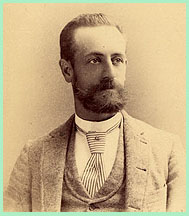Announcing our 29th Spring House Tour & Reception
Berkeley 1890
“At Home” along Fulton Street
Sunday, 9 May 2004, One to Five o’clock

Featuring twelve Victorian-era homes
Tour map, illustrated guidebook & refreshments providedGeneral $25; BAHA members & guests $20
(discount limit: 2 guests per individual member; 4 per household)To order tickets, please print and fill out the ticket order form.
Tour-day ticket booth will open at noon at Ward & Fulton Sts.

The architecture of Berkeley is free and of great variety. It is not limited in regard to style. Touches of the Renaissance are mingled with traces of the time of Queen Anne, outlines of the Swiss Chalet, and ideas that are strictly modern and Californian. The learned professor lives in a trellised cottage surrounded by a lawn filled with evergreens, roses, and exotics. The capitalist whose business is in the city builds with equal taste, but with more architectural ambition. The most exacting taste can be suited in respect of location. Those who select the hill-sides command a view of the town, and the wide panorama of the bay; while those who choose to live further down the plateau can see both the bay and the hills.
Berkeley, California Illustrated and Described, circa 1889
Fulton Street in the Victorian Era
The architectural charms of 1890 Berkeley were much ballyhooed in promotional pamphlets such as the one quoted above. Having been first settled in the 1850s, by the 1890s Berkeley was a rural-like town of wooden Victorian homes. Incorporated in 1878, Berkeley combined a small college settlement surrounding the University with a working class village along the shores of the bay.
By the 1890s, Berkeley’s many newly built houses displayed unabashedly the whimsical stylized wood-turned ornamentation of the day, most likely produced in one of the city’s several planing mills. The small, refined Italianate cottages of the pioneer times were joined by large family homes in Stick-Eastlake or Queen Anne styles, and by the Carpenter Gothic fantasies of the town’s elite. Whether modest or grand, the front of each house was embellished by a flower garden, enclosed by either a low cast-iron fence or white-painted pickets, and the effect was that of a pleasant old-fashioned village.
Spiero house (photo: Daniella Thompson, 2004)For much of the 20th century, Berkeley’s Victorian legacy (and Victorian buildings everywhere else, too) went out of fashion. A movement began—in fact, in Berkeley—to design houses without Victorian ornament, extolling the virtues of the simple, unadorned home with an unpainted exterior. Soon after 1900, those who could afford to do so altered their Victorian homes, both inside and out. Berkeley’s wooden, turreted downtown buildings quickly gave way to classically inspired brick buildings, and the Phoebe Hearst International Architectural Competition for the University of California was expected to rid the campus of its 19th-century buildings. Berkeley’s largest concentration of stately Victorian homes surrounding the campus, set within oversized “villa” lots, were the first to disappear.
In the 1930s, whole neighborhoods began to be replaced by campus expansion projects. During the apartment building boom of the 1950s and ’60s, scattered Victorians in other parts of the city were usually the first to go.

In today’s central Berkeley, after more than a hundred years of change, it is difficult to find a neighborhood that is still evocative of the 19th century. Happily, a few such enclaves do exist, especially along and about Fulton Street, as it stretches between the University campus and Berkeley’s southern boundary. Although only a block away from busy Shattuck Avenue—which in the 1890s was served by both steam train and electric streetcars—Fulton is now a quiet street, secluded from the hustle and bustle of urban life. This neighborhood awaits discovery on BAHA’s 2004 Spring House Tour, when you are invited to call at ten Victorian-era houses.
Tape house (photo: Daniella Thompson, 2004)Pre-tour Lectures
Lecture No. 1
Victorian Glory in the San Francisco Bay Area
by Paul Duchscherer
Wednesday, 28 AprilLecture No. 2
A.W. Pattiani, Victorian Designer-Builder
by Paul Roberts
Both lectures will take place at the Church by the Side of the Road,
Wednesday, 5 May
2108 Russell Street, at 7:30 pm. Admission $7.The Church by the Side of the Road (Henry F. Starbuck, 1908) is City of Berkeley Landmark No. 70, Structure of Merit.
For additional information, call (510) 841-2242
We need house tour docents. To volunteer, call (510) 845-1632.
Copyright © 2004–2011 BAHA. All rights reserved. A.W. Pattiani photo courtesy of the Pattiani family.








